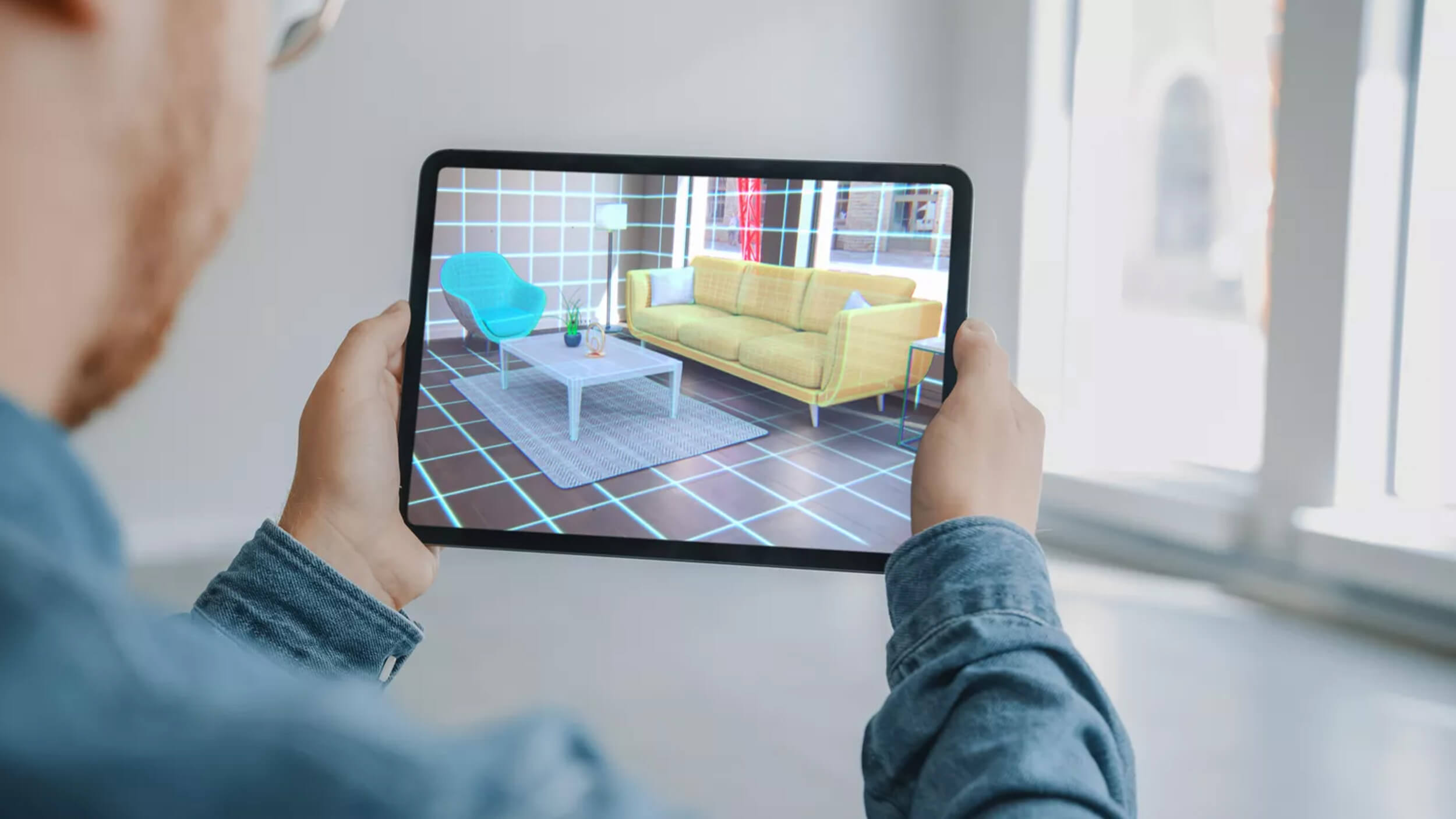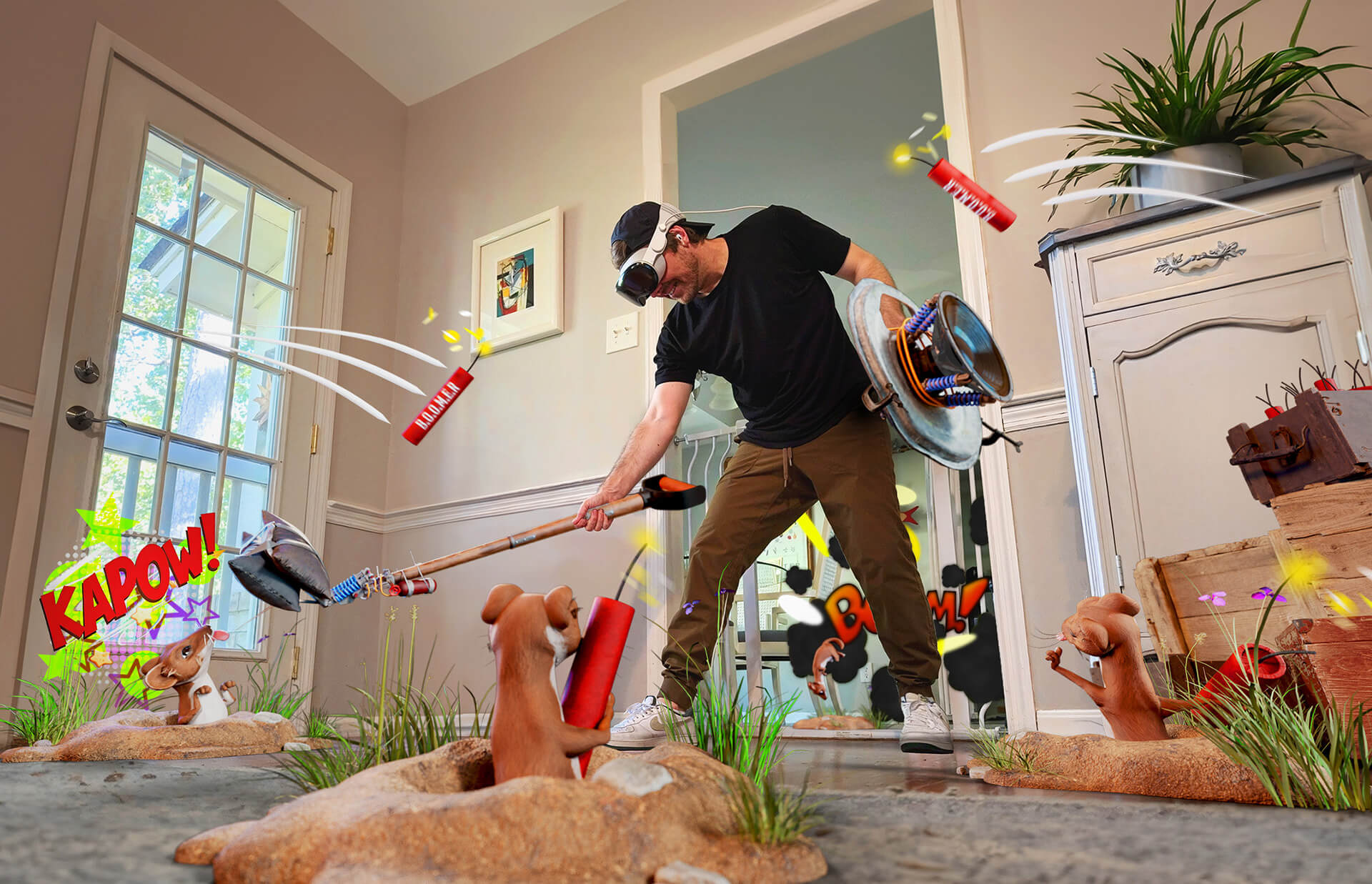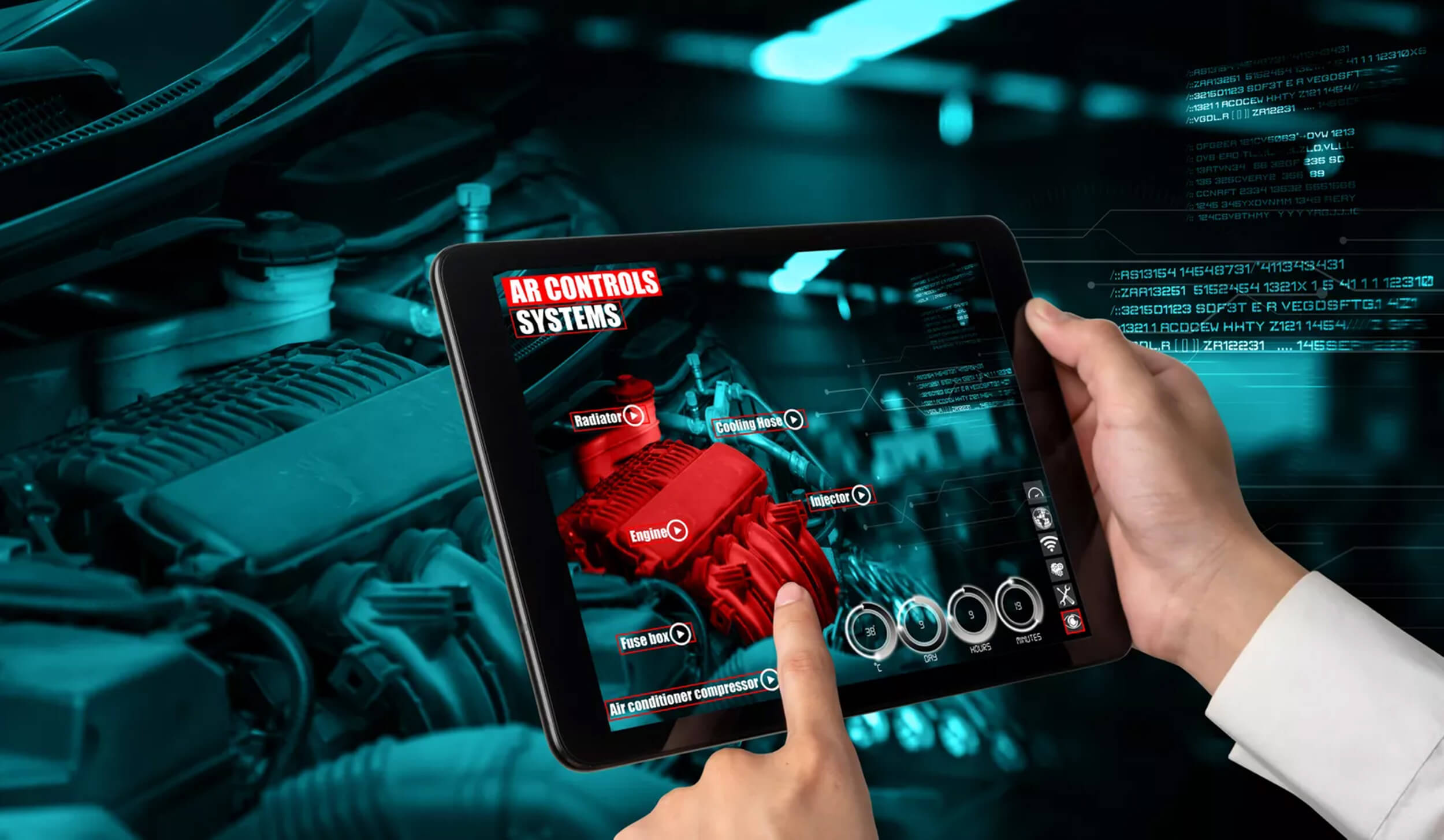Augmented Reality (AR) is a hot technology for combining digital imagery with what we see organically. There are two common approaches to delivering AR experiences: custom apps and web-based experiences (WebAR). These two techniques are battling it out in the marketplace, with one approach is coming out ahead… and for good reason.
Augmented reality has exploded in popularity. In the coming years, experts predict there will be 1.7 billion mobile AR users globally. This represents a stunning rise of 1.5 billion from the 200 million users in 2015. The broader market for extended reality (XR), which includes not only AR but also the related technologies virtual reality (VR) and mixed reality (MR), is expected to expand dramatically from $30 billion to $300 billion by 2024.
If there’s a massive technology trend, this is it; but it’s critical to know the difference between WebAR and AR apps.
What is WebAR?
Web-based augmented reality, or WebAR, is the use of standardized web technologies to produce AR experiences. It works in real-time, through a web browser on the user’s smartphone or other devices. Users don’t need to download any apps, as commonly available platforms already support the technology.
WebAR automatically works on any browser regardless of the hardware or operating system. This eliminates the need to download custom apps. This is an important consideration because studies show there’s a 50% drop in engagement when users have to go through a download. After that, only 25% of people use the app beyond the first interaction.
WebAR is easily accessible with just a simple URL link, scan of a QR code, or tap on an NFC tag. This enables AR experiences to be enjoyed across most mobile devices and browsers without requiring users to download an entire application. This broad accessibility means WebAR reaches twice as many mobile devices as its app-based counterpart. This lowers entry barriers for users and ensures a broader reach for content producers.

Source: Shutterstock
AR’s reach is making big waves in the marketplace. Swedish furniture retailer Ikea is leveraging Augmented Reality so customers can, through their smartphones, preview how furniture looks in their homes before they buy. Michael Valdsgaard, head of the company’s digital transformation efforts has described the potential uplift in sales from AR as a “dream scenario” for Ikea.
“Most people postpone a purchase because they’re not comfortable making the decision if they aren’t sure the color is going to match [the rest of the room] or it fits the style. Now, we can give them [those answers] in their hands, while letting them have fun with home furnishing for free and with no effort.”
The same technique can also work with food and beverages, clothing and accessories, and practically any other product or service. WebAR is a web-based Augmented Reality technique to engage with audiences in a fun and easy manner. With investment dollars pouring in, WebAR is on course to become an essential part of the web and the economy.
What Are AR Apps?
AR apps are Augmented Reality programs written specifically for a platform such as Android or iPhone. AR apps require custom software development, making AR apps more expensive than WebAR.

There are several different software frameworks for coding AR apps. These include versions by Apple and Google for their respective mobile operating systems, as well as JavaScript versions for any device. A developer can use these frameworks as part of the process to develop a custom AR app.
AR apps not only cost more to develop, but they can interrupt the user experience. An AR app requires users to download and install it. Right away, you’ve lost many potential customers as many people are turned off by having to download an app to enjoy an AR experience.
In some instances, there are methods to accomplish a project goal with either AR apps or WebAR that differ mainly “under the hood,” i.e. in their technical approach. For example, AR app frameworks include tools for locating users within scenes, while WebAR can do the same using its own functionality. AR apps with their custom coding can access some of the lower-level features of a mobile device, such as graphics co-processors.
Developers can enable the same fundamental AR experiences with either custom apps or WebAR. The differences have to do with which tools and techniques they will use and how customers run the content. AR apps started off as the default method to build experiences, then WebAR came along and expanded on those experiences.
Keep up to date
Sign up to our newsletter for exclusive updates and content, delivered directly to your inbox.
Top WebAR Advantages
As opposed to developing an app, implementing WebAR does not require any coding experience or knowledge. Usually, all it takes is a QR code that will direct users to the web-based AR platform and you’re good to go. WebAR is easier to develop, easier to maintain, easier to track with analytics, costs less, and requires no updates.
Compatible With Most Web Browsers
WebAR works with the browsers that people already have and use. You can run WebAR experiences on Google Chrome, Apple Safari, Microsoft Edge, Mozilla Firefox, and others. This makes it much more accessible than downloaded apps. Around three and a half billion Android and Apple devices already support WebAR.
The cross-browser compatibility of WebAR also makes it much simpler to develop. You create the experience once and it runs the same on any browser or operating system. Gone are the days of having to write a completely different app for each platform you want to support. Users just browse to your website and immerse themselves in a WebAR experience. Whether someone follows a web link from Firefox on Android or snaps a QR code from Safari on Apple iOS, they get the same Augmented Reality experience.
You can offer your customers a range of other choices to access WebAR experiences. Send them short URLs or SMS text messages, embed NFC chips in your products, or offer links from social media platforms such as Facebook, Instagram, or LinkedIn.
No Downloads, No Hassle For Users
People are reluctant to download software onto their phones, especially for one-off applications that will clog their systems. This reluctance prevents many AR apps from ever getting used, but WebAR is immune since it involves no downloads.
WebAR reduces the number of steps for users from six (as is the case with downloaded apps) to just two: start the WebAR experience, then allow camera access. This is much easier for people and results in more users of your Augmented Reality experience. You want as many users as possible, WebAR accessibility makes this possible.
Since WebAR offers the same basic experience as AR apps but without the downloads, this web-based technology is rapidly gaining traction in the marketplace. Developers recognize that having to download and install an app represents the largest hurdle to adoption. The lack of any downloads also makes WebAR faster to deploy. Users don’t have to wait for a large download to finish before they can enjoy their AR experience. Instead, they can just tap on a link and begin their AR journey.
No App, No Updates Required
Since WebAR does not require users to download an app, they also don’t have to update any apps. When apps force people to update it frustrates customers. WebAR does away with forced updates. Instead, automatically deliver new content through your website, with minimal effort or disruption for the user.
People who use your WebAR experience will have the latest version of your content. That’s what’s available on your site. And their software is up to date too, since it’s the web browser that they’re already accustomed to running. Thus WebAR is easier and safer for users in comparison to downloaded AR apps that customers would need to update.
Easy To Track Analytics
Since WebAR works through the web, it gives you access to detailed analytics, such as user behavior. This valuable data helps you to better understand your customers and how they engage with your content. Here, RPR offers you a custom analytics dashboard that is compatible with Google analytics.
Let’s chat
Not sure where to start? Book a free strategy call with us to get started! No strings attached.

WebAR analytics offers the information so you can assess how people respond to your marketing efforts. In addition to measuring how many likes or shares your WebAR projects garner, it also offers more detailed data including dwell time (how long people engage in the experience) and spatial analytics (which areas of a scene people use).
Pageviews (when a browser loads a page on your site) are the starting point in any analytics report. Every load event, including refreshing the page, is counted as a single view. Analytics count page views from a single user (IP address) to record users’ frequency and return rate. Are people watching your content often, or just once? Are people tapping your links or scanning your QR codes? This data can help determine the replay value of the WebAR experience. The better the replay value, the more cost-effective the WebAR investment is.
Dwell time is another solid indicator of how compelling your content is. Do users leave a five-minute WebAR experience after a few seconds, or do they watch the whole thing? On average, people spend around two minutes on WebAR content. A longer dwell time indicates more compelling content.
Engagement rate is a social metric that measures the level of interaction of WebAR content among users. Instead of simply counting the number of likes, shares, and comments, it follows a formula that divides total interactions by the number of followers and then multiplied by 100. This provides a better, more accurate measurement of content performance compared to absolute measures such as likes, shares, and comments. It standardizes the measurement of social actions, making it easier to compare multiple different experiences against each other.
Measuring audience engagement allows you to feed the statistical knowledge into your future projects. You can then target the channels that perform well. WebAR increases average dwell time as well as conversion rates. Prospective customers feel a greater connection with products and develop a more favorable opinion of brands that use WebAR. Over half of major brands are now turning to immersive technologies like these to build brand image.
Spatial analytics is a new measurement category specifically for AR and VR. It uses data from users immersed in the experience, measuring how much time they spend on specific areas or objects within the scene. The summary statistics tell you which content is captivating and which content is less interesting. Armed with these insights, you can make the necessary tweaks to optimize the user experience.
WebAR experiences incorporate data from Google analytics including the number of visits, the number of unique visitors, and the number of users who allow camera access. These nuggets help paint a detailed picture of your users. For instance, you may have thousands of visits from a few hundred visitors who are referred to your site from a search engine, or you may have ten thousand visits each from a different visitor, referred from several different websites.
Given that the WebAR experience requires the use of a camera, the metric that records the number of visitors who allow access to their cameras gives a precise indication of the WebAR’s acceptance rate to play. Rejecting the request for camera access is equivalent to abandoning the experience before it even started.
Pulling together the various data from analytics, you can determine whether you have many visitors but low engagement, or few visitors but higher engagement, or many unique visitors with high engagement focusing on certain of your spatial assets. These combined insights give you the information you need to enhance your AR offerings.
Easy To Build
Developing WebAR experiences is markedly easier than developing full-blown AR apps. Developing WebAR projects is similar to building ordinary websites, but with the addition of libraries for such features as detecting the device’s location and orientation, and producing 3D graphics.
By contrast, developing custom AR apps requires more intensive coding with platform-specific toolkits. This approach also entails testing and distributing the app, which adds to the cost and complexity. Using the simpler WebAR allows you to start small and expand.
Also, thanks to its use of standard web technologies, WebAR is easy to combine with other solutions. For instance, developers can use AJAX for updating the webpage in real-time, and social media APIs to log users in and facilitate sharing.
Low Cost, Low Maintenance
WebAR is much more affordable to produce than custom AR apps, and also much easier to maintain. Compared to the demanding process to write and maintain AR apps, WebAR is more like running a website… the tools are there to make this fairly straightforward and manageable.

Source: Shutterstock
While WebAR costs less and is easier to maintain, it retains the core features of Augmented Reality including 3D animations and portals. Much of the cost of developing traditional AR apps go into producing and maintaining a complex software program, which is unnecessary when one uses the available functionality of a web browser.
Crafting a WebAR experience costs considerably less than developing a traditional AR app, and operational expenses are drastically lower too. You can reinvest some of the savings into improving your content, or pocket it as profit.
WebAR: Are There Any Drawbacks?
As with any technology, there are some drawbacks to WebAR. Running an augmented reality experience within the web browser constrains the available memory and features somewhat, resulting in fewer bells and whistles than AR apps. Nonetheless, WebAR supports enough features for most purposes.
WebAR has somewhat higher latency than traditional apps, meaning certain scenes may not seem as responsive. With modern devices and data connections, this shouldn’t pose too much of an obstacle. An AR app’s direct hardware access also allows for certain user interface features that web browsers may block, which may come in handy under certain circumstances.
Due to the constraints on hardware and network resources, WebAR experiences are generally slightly shorter and less detailed than traditional AR app experiences. For most use cases, however, WebAR more than compensates due to its accessibility on all smartphones. For extremely detailed scenes, however, one may prefer to develop a more expensive AR app.
Integrate WebAR For Your Business
Ultimately, WebAR and AR apps offer the same core functionality, but there are marked differences between them. WebAR makes use of a web browser to deliver Augmented Reality functionality, which means it can be run on any device with graphics capability. It also eliminates hardware costs for users (i.e. purchasing an AR headset). In contrast, AR apps require a specific platform in order to run, an added expense for businesses seeking that functionality.
Unlike app-based AR that requires the user to download and store an application on their phone (taking up time and space), WebAR is app-less, requires no downloads, and is a lower barrier to entry for users. AR Applications take 6 steps to initiate, while WebAR only takes 2. It’s no surprise that WebAR is exploding in popularity, with many companies already investing in it and millions of people using it each day.
WebAR is definitely the better choice if you’re looking for a more versatile, analytics-driven, frictionless, less resource-dependent tool to offer AR experiences directly from users’ smartphones. This technology enables users to participate in a uniform AR experience across various devices, browsers, and operating systems without the hassle of an app download. WebAR simply costs less and is easier to maintain and is rapidly replacing costlier traditional AR apps as the go-to method to bring one’s message to market.
WebAR enables people to instantly access AR without a download. This results in a smooth user experience, greater reach, higher conversions, increased shareability, and ultimately, more sales. In order to get the most out of WebAR, it’s important for brands to find a competent and experienced AR partner. Rock Paper Reality (RPR) is a veteran in the industry with over a decade of experience at the cutting edge of this technology.
RPR has created dozens of successful WebAR campaigns for brands such as Lenovo, Microsoft, and Netflix. Working with clients from conception to deployment, RPR has provided partners with the benefits of best-in-class Augmented Reality.
Looking to leverage WebAR to take your marketing efforts to the next level, get in touch with the Rock Paper Reality team today lets us help you offer customers a compelling experience that’s as easy as browsing the web.
Before you go, check out our WebAR hologram of RPR’s CEO grooving… but only if you promise not to judge (or steal) his moves… Start your AR experience now!

